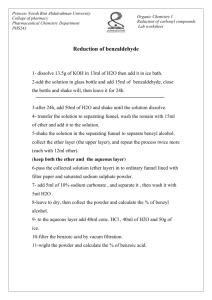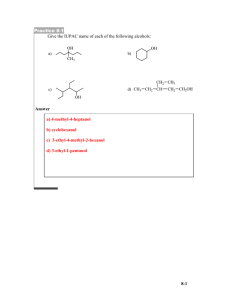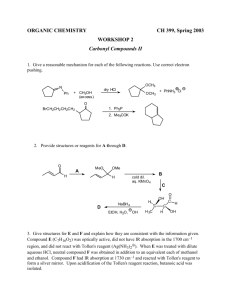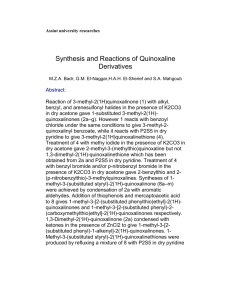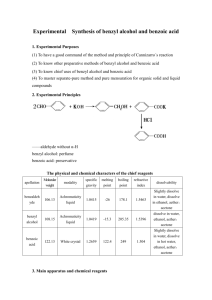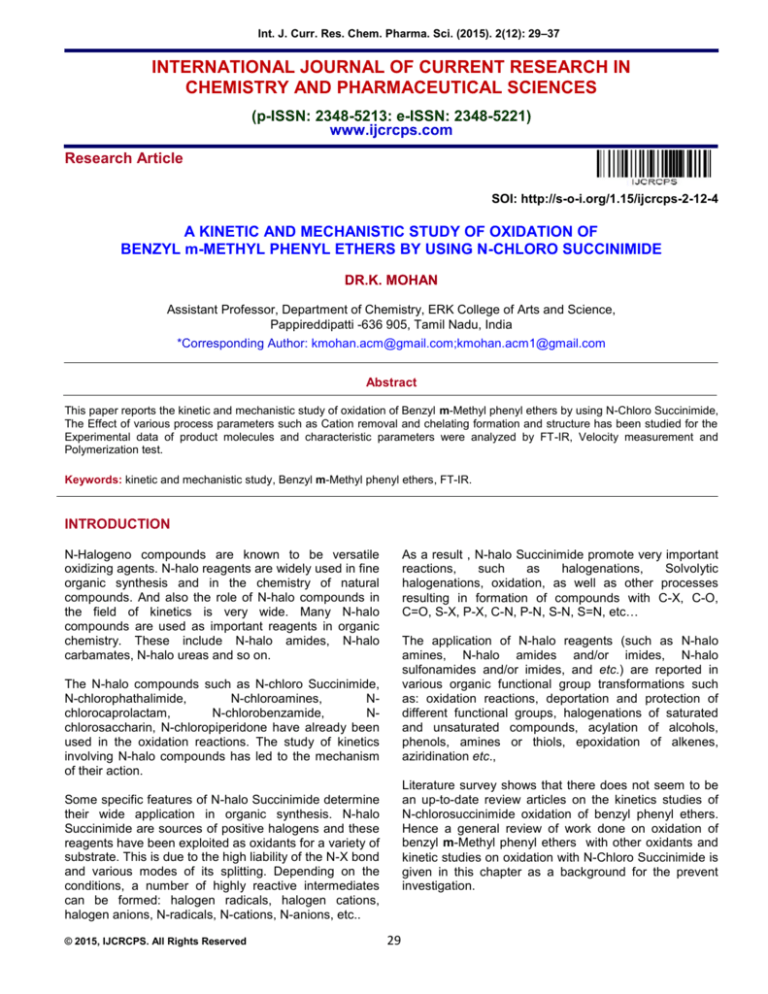
Int. J. Curr. Res. Chem. Pharma. Sci. (2015). 2(12): 29–37
INTERNATIONAL JOURNAL OF CURRENT RESEARCH IN
CHEMISTRY AND PHARMACEUTICAL SCIENCES
(p-ISSN: 2348-5213: e-ISSN: 2348-5221)
www.ijcrcps.com
Research Article
SOI: http://s-o-i.org/1.15/ijcrcps-2-12-4
A KINETIC AND MECHANISTIC STUDY OF OXIDATION OF
BENZYL m-METHYL PHENYL ETHERS BY USING N-CHLORO SUCCINIMIDE
DR.K. MOHAN
Assistant Professor, Department of Chemistry, ERK College of Arts and Science,
Pappireddipatti -636 905, Tamil Nadu, India
*Corresponding Author: kmohan.acm@gmail.com;kmohan.acm1@gmail.com
Abstract
This paper reports the kinetic and mechanistic study of oxidation of Benzyl m-Methyl phenyl ethers by using N-Chloro Succinimide,
The Effect of various process parameters such as Cation removal and chelating formation and structure has been studied for the
Experimental data of product molecules and characteristic parameters were analyzed by FT-IR, Velocity measurement and
Polymerization test.
Keywords: kinetic and mechanistic study, Benzyl m-Methyl phenyl ethers, FT-IR.
INTRODUCTION
N-Halogeno compounds are known to be versatile
oxidizing agents. N-halo reagents are widely used in fine
organic synthesis and in the chemistry of natural
compounds. And also the role of N-halo compounds in
the field of kinetics is very wide. Many N-halo
compounds are used as important reagents in organic
chemistry. These include N-halo amides, N-halo
carbamates, N-halo ureas and so on.
As a result , N-halo Succinimide promote very important
reactions,
such
as
halogenations,
Solvolytic
halogenations, oxidation, as well as other processes
resulting in formation of compounds with C-X, C-O,
C=O, S-X, P-X, C-N, P-N, S-N, S=N, etc…
The application of N-halo reagents (such as N-halo
amines, N-halo amides and/or imides, N-halo
sulfonamides and/or imides, and etc.) are reported in
various organic functional group transformations such
as: oxidation reactions, deportation and protection of
different functional groups, halogenations of saturated
and unsaturated compounds, acylation of alcohols,
phenols, amines or thiols, epoxidation of alkenes,
aziridination etc.,
The N-halo compounds such as N-chloro Succinimide,
N-chlorophathalimide,
N-chloroamines,
Nchlorocaprolactam,
N-chlorobenzamide,
Nchlorosaccharin, N-chloropiperidone have already been
used in the oxidation reactions. The study of kinetics
involving N-halo compounds has led to the mechanism
of their action.
Literature survey shows that there does not seem to be
an up-to-date review articles on the kinetics studies of
N-chlorosuccinimide oxidation of benzyl phenyl ethers.
Hence a general review of work done on oxidation of
benzyl m-Methyl phenyl ethers with other oxidants and
kinetic studies on oxidation with N-Chloro Succinimide is
given in this chapter as a background for the prevent
investigation.
Some specific features of N-halo Succinimide determine
their wide application in organic synthesis. N-halo
Succinimide are sources of positive halogens and these
reagents have been exploited as oxidants for a variety of
substrate. This is due to the high liability of the N-X bond
and various modes of its splitting. Depending on the
conditions, a number of highly reactive intermediates
can be formed: halogen radicals, halogen cations,
halogen anions, N-radicals, N-cations, N-anions, etc..
© 2015, IJCRCPS. All Rights Reserved
29
Int. J. Curr. Res. Chem. Pharma. Sci. (2015). 2(12): 29–37
N- CHLORO SUCCINIMIDE:
rearrangements, and functional group transformations.
It can be used as pharmaceutical intermediates,
organic synthesis chlorinating agent. It can also be
used to prepare rubber additives, antibiotic drug
intermediates. N-Chloro Succinimide is also used as
an intermediate or a chlorinating agent in the synthesis
of pharmaceuticals especially for tetracycline
antibiotics.
N-Chloro Succinimide (NCS) is a versatile reagent and
its significance is not limited to chlorination and
7
oxidation . It is used as a source for chlorine in radical
reactions and various electrophilic additions. It
mediates or catalyzes many chemical reactions,
including halocyclizations, formation of heterocyclic
systems, and formation of new carbon-carbon bonds,
OXIDATION OF BENZYL ETHERS BY N-BROMOSUCCINIMIDE:
Kinetics of oxidation of benzyl ethers by N-Bromo
Succinimide (NBS) in 80% aqueous acetic acid had
31
been reported . Here the reaction followed first order
kinetics with respect to both [NBS] and [substrate].
The effect of varying ionic strength and dielectric
constant indicated that the reaction was a dipoledipole type. The product of oxidation was found to be
Benzaldehyde
The mechanism proposed for the oxidation of benzyl ether by NBS.
k1
NBS + Benzyl ether
complex
k2
Complex Product
Rate = k1 [NBS] [Benzyl ether]
... (slow)
... (fast)
O
H5 C 6
CH2
O
R + Br
R = alkyl groups
N
Slow
O
O
H5 C 6
O
Br
HC
N
H
O
Complex
fast
+
H5 C 6
CH
O
R + Br +
fast
© 2015, IJCRCPS. All Rights Reserved
30C6H5CHO + RBr
NH
Int. J. Curr. Res. Chem. Pharma. Sci. (2015). 2(12): 29–37
MATERIALS AND METHODS
The flask was cooled and the contents were poured
into excess of water. The sodium chloride dissolves in
excess of water and benzyl o-methyl phenyl ether was
separated by using the separating funnel. It was
washed well with distilled water and distilled under
vacuum (or) low pressure distillation.
REAGENTS
ACETIC ACID:
500 ml at ordinary glacial acetic acid was taken in a
one liter round bottomed flask. 20 g of solid chromium
tri-oxide was added. The flask was refluxed in water
condenser for about four hours. It was then cooled
and distilled. Pure acetic acid was collected at 118°C
and stored in closed brown bottles.
Benzyl m-methyl phenyl ether
About 52.3ml of distilled m-methyl phenol was taken in
a round bottomed flask and a piece of calculated
amount of metallic sodium was added till the maximum
amount was dissolved. The sodium m-methyl
phenoxide formed was cooled. Required quantity of
distilled benzyl chloride should be added. Benzyl
chloride reacts with sodium phenoxide to form benzyl
m-methyl phenyl ether and sodium chloride.
PHENOLS:
Phenol, m-methyl phenol,
p-nitro phenol were
purified by the standard method.
BENZYL CHLORIDE:
Benzyl chloride was used as such.
m–CH3 C6H4OH + Na m–CH3C6H4ONa
m-CH3
C6H4ONa
+
C6H5CH2Cl
C6H5CH2OC6H4CH3–m + NaCl
OXIDANT
Commercial sample of N-Chloro Succinimide was
used as such.
The flask was cooled and the contents were poured
into excess of water. The sodium chloride dissolves in
excess of water and benzyl m-methyl phenyl ether
was separated by using the separating funnel. It was
washed well with distilled water and distilled under
vacuum (or) low pressure distillation.
PREPARATION OF BENZYL PHENYL ETHERS
Benzyl phenyl ether
About 43.9ml of distilled phenol was taken in a round
bottomed flask and a piece of calculated amount of
metallic sodium was added till the maximum amount
was dissolved. The sodium phenoxide formed was
cooled. Required quantity of distilled benzyl chloride
should be added. Benzyl chloride reacts with sodium
phenoxide to form benzyl phenyl ether and sodium
chloride.
Physical measurements
Infrared Spectra
The infrared spectra of all the complexes were
recorded on a Perkin Elmer FT-IR Spectrometer in the
-1
range of 4000 – 400 cm using KBr pellets.
C6H5OH + Na C6H5ONa
C6H5ONa + C6H5CH2Cl C6H5CH2OC6H5 + NaCl
FT-IR Spectrum of Benzyl phenyl ether
© 2015, IJCRCPS. All Rights Reserved
31
Int. J. Curr. Res. Chem. Pharma. Sci. (2015). 2(12): 29–37
FT-IR Spectrum of Benzyl m-methyl phenyl ether
KINETIC METHODS
one mole of benzyl phenyl ethers consumed two
moles of NCS.
Preparation of standard solution:
Product study:
The standard stock solution of NCS was prepared by
dissolving the required quantity of it in water and
standardized by titrating against standard sodium
thiosulphate solution iodometrically.
This NCS
solution was found to be invariant in its strength over a
period of three months. The benzyl phenyl ether
solutions were prepared by dissolving required
quantity of them in acetic acid and water mixture (v/v).
For product study, the substrate was taken in excess
compared to concentration of oxidant. The reaction
mixture was kept aside for about 48 hours for the
completion of the reaction. After that the residual
mixture was poured into a separating funnel. Solvent
ether was added and shaken well. Then it was
washed with distilled water and the ether layer was
separated, dried with anhydrous sodium sulphate.
After washing several times with water, it was dried
and the product was analyzed. The major product
was found to be Benzaldehyde. It was confirmed by
TLC.
Velocity measurement
In a typical experiment, the required quantities of the
benzyl phenyl ether solution, hydrochloric acid, sodium
per chlorate and acetic acid – water mixture were
pipetted out in a clean dried reaction bottle, kept in
thermostat, set at the desired temperature. The
reaction was started by pipetting out the required
quantity of NCS solution, which had also been thermo
stated for nearly half an hour. The total volume of the
reaction mixture was always 25 ml. 3ml of reaction
mixture was pipetted out into the conical flask and the
progress of the reaction was followed iodometrically.
Polymerization test:
Addition of definite concentration of methyl
methacrylate solution to the reaction mixture did not
affect the rate of the reaction, which indicates the noninvolvement of the free radical intermediate during the
oxidation of benzyl phenyl ether by NCS.
Thermodynamic parameters
In kinetics, the variation of reaction rate with
temperature is usually expressed by the Arrhenius
equation, which in its integrated form is
Investigation of stoichiometry:
The stoichiometry of the reaction [NCS]:[benzyl phenyl
ethers] was determined by taking excess of NCS over
the substrate and the allowing the reaction for
completion since the concentration of the benzyl
phenyl ethers taken was less compared to that of
NCS, all the benzyl phenyl ethers taken would have
been completely reacted leaving behind the unreacted
NCS, the concentration of which was estimated by
iodometry. Estimation of unreacted NCS showed that
© 2015, IJCRCPS. All Rights Reserved
log k = log A –
Ea
2.303 RT
Where,
k - is the rate constant at temperature T
A - is the pre-exponential factor
Ea - is the Arrhenius activation energy
R – is the universal gas constant
32
Int. J. Curr. Res. Chem. Pharma. Sci. (2015). 2(12): 29–37
This equation is in accord with the experimental fact
that for the most of the reactions, a plot of log k versus
1/T is a straight line.
Where
A
H
S
G
Kb
h
The slope of the line is –Ea / 2.303 R.; Ea calculated in
this way is known as the Arrhenius activation energy.
From the calculated Ea, the other thermodynamic
parameters are calculated using the following
expressions.
–
–
–
–
–
–
Pre exponential factor
Enthalpy of activation
Entropy of activation
Free energy of activation
Boltzmann constant
Plank’s constant
RESULT AND DISSCUSION
– Ea/RT
k = Ae
The enthalpy of activation H can be calculated from
the equation
In the present study, a series of benzyl phenyl ethers
have been chosen to study the kinetics and
mechanism of oxidation by NCS. Benzaldehyde is the
major product of oxidation. The rates of the reaction
were measured by following the disappearance of
NCS iodometrically in acetic acid medium. The kinetic
study of oxidation had been carried out in the
presence of HCl and NaClO4.
H = Ea – RT
The free energy of activation G is given by
G=H-TS
The entropy of activation S is given by Eyeing
equation
k=
OXIDATION OF BENZYL PHENYL ETHER WITH
NCS:
A=
Order of Reaction With Respect to NCS:
×
A plot of log [NCN] Vs time is linear indicating firstorder dependence on [NCS] [Fig.1]. A typical kinetic
run has been shown in TABLE 1
×
A typical kinetic run for the NCS oxidation of benzyl methyl ether
-2
-3
[Benzyl phenyl ether]= 210 M
Solvent=80% CH3COOH(v/v)
[NaClO4]= 0.1M
Time in seconds
300
600
900
1200
1500
1800
[NCS]= 310 M
[HCl]=0.1M
Temperature=318K
log[NCS] ,where[NCS] = a- x
0.7993
0.6532
0.5052
0.3802
0.2041
0.0414
Effect of variation of NCS Concentration:
The oxidation was carried out with different initial
Concentrations of NCS and the results are given in
Table 2.
TABLE 2 Effect of concentration of NCS on the reaction rate
-2
[Benzyl phenyl ether]= 210 M
Solvent=80% CH3COOH(v/v)
Temperature=318K
4 -1
3
Kobsx10 s
8.21
11.51
13.43
14.97
17.27
19.20
[NCS]10 M
2.0
3.0
4.0
5.0
6.0
7.0
© 2015, IJCRCPS. All Rights Reserved
[HCl]=0.1M
[NaClO4]= 0.1M
33
Int. J. Curr. Res. Chem. Pharma. Sci. (2015). 2(12): 29–37
Order with respect to substrate:
It is seen that the pseudo first-order rate constant
increases with increase in the initial concentration of
the oxidant. But in each kinetic run, the reaction shows
no deviation from the first order plot of log [NCS] Vs
time.
Effect of Variation of Benzyl Phenyl Ether
Concentration:
The rate of oxidation was carried out with different
initial concentration of benzyl phenyl ether and
keeping the [NCS] as constant (Table 3). The rate of
the reaction remains constant with increase in the
concentration of the substrate. It is found that the
reaction follows zero order kinetics with respect to
substrate.
The values of the rate constants of other benzyl
phenyl ethers also increase with increase in initial
concentration of NCS. However it must be stressed
that the reaction follows first-order with respect to
oxidant at every one of these concentrations.
TABLE 3 Variation kobs with Benzyl phenyl ether
-3
[NCS]= 310 M
Solvent=80% CH3COOH(v/v)
Temperature=318K
[HCl]=0.1M
[NaClO4]= 0.1M
4
2
[BPE]10 M
1.0
2.0
Kobsx10 s
11.43
11.51
3.0
4.0
5.0
6.0
11.20
11.43
12.08
11.56
Effect of Succinimide on Reaction Rate:
-1
the concentration of benzyl phenyl ether and NCS
constant. The rate of the reaction remains constant
with the increase in the initially added amount of
Succinimide
The effect of Succinimide on reaction rate was studied
by adding different amounts of Succinimide, keeping
TABLE 4 Variation of kobs with added Succinimide
-2
[Benzyl phenyl ether]= 210 M
Solvent=80% CH3COOH (v/v)
[NaClO4]= 0.1M
4
3
Kobsx10 s
[NH]10 M
1.0
2.0
3.0
4.0
5.0
6.0
-1
10.21
10.47
10.55
10.07
10.13
10.27
Effect of variation of HCl concentration:
ether] and [NCS] (Table 4). In all these cases, the
reaction rate increases with the increase in [HCl]. The
plot of log kobs Vs log [HCl] is found to be linear with
positive and unit slope
The influence of variation of acid concentration on the
reaction rate was studied by varying the concentration
of added hydrochloric acid at constant [benzyl phenyl
© 2015, IJCRCPS. All Rights Reserved
-3
[NCS]= 310 M
[HCl] =0.1M
Temperature=318K
34
Int. J. Curr. Res. Chem. Pharma. Sci. (2015). 2(12): 29–37
Table 5 Variation of kobs with [HCl]
-2
[Benzyl phenyl ether]= 210 M
Solvent=80% CH3COOH(v/v)
Temperature=318K
4
[HCl]10 M
Kobsx10 s
0.2
0.4
0.6
0.8
1.0
1.2
1.4
1.6
2.45
4.78
7.52
9.52
11.51
15.28
18.04
19.98
OXIDATION OF OTHER BENZYL PHENYL ETHERS
BY NCS:
-1
CONCLUSION
Before suggesting a probable mechanism for the
oxidation of benzyl phenyl ethers by NCS, the kinetic
results of the present investigation are summed up as
follows.
The oxidation of other Benzyl phenyl ethers, Benzyl mmethyl phenyl ether, Benzyl p-methyl phenyl ether has
been studied for the purpose of comparison under
pseudo-first order conditions in the presence of HCl,
NaClO4. All the benzyl phenyl ethers have been
oxidized to Benzaldehyde by NCS.
1. The reaction is first order with respect to the
oxidant [NCS], and there is a increase in the
values of the rate constants with increase in
the initial concentration of the oxidant.
2. The reaction is zero order with respect to the
[substrate], and
the values of the rate
constants remains constant with increase in
the initial concentration of the substrate.
3. The rate of oxidation increases with the
increase in the concentration of HCl.
4. The rate of the reaction is insensitive to
change in NaClO4 concentration.
5. Increase in the percentage of acetic acid in
the binary solvent mixture of acetic acid and
water increases the rate.
6. Increase in temperature increases the rate of
the reaction and the plots of log kobs Vs 1/T
are linear for all the benzyl phenyl ethers. The
entropy of activation is negative for all the
benzyl phenyl ethers.
7. Initial addition of one of the products viz.,
nicotinamide, to the reaction mixture has a
retarding effect on rate of oxidation.
The rate studies were conducted with variation in the
initial concentration of NCS at constant substrate
concentration. The results have been presented in
Table 9. The data reveal a increase in the first order
rate constants with an increase in the concentration of
NCS.
The zero order dependence of the rate of various
benzyl phenyl ethers is inferred from the observation
that increases in ether concentration, the rate of
oxidation remains constant.
The kinetics of the effect of variation of [HCl] on the
NCS oxidation of benzyl Phenyl Ethers were studied.
The results show a increase in the rate with increase
in the concentration of hydrochloric acid
Kinetic runs were carried out for all the benzyl phenyl
ethers to study the effect of solvent polarity on the rate
of oxidation by NCS. The results shown that the rate of
oxidation increases with increase in the percentage of
acetic acid in the binary solvent mixture of acetic acid
and water,. Plot of log kobs Vs 1/D is linear with positive
and unit slope for all benzyl phenyl ethers.
Kinetic studies on NCS oxidation:
The active oxidizing species has to be identified,
before suggesting a most probable mechanism. The
possible oxidizing species under the experimental
+
+
conditions are Cl2, HOCl, H2OCl and NCSH in
+
aqueous solution. H2OBr is the active oxidizing
species in the oxidation of 4-Oxoacids by N44
bromosuccinimide .
In
the
oxidation
of
4
46
thiosemicarbazide , maleic and crotonic acid by N+
Chloro Succinimide, H2OCl is the active oxidant.
The effect of Succinimide on reaction rate was studied
by adding different amounts of Succinimide for all the
benzyl phenyl ethers. The data in Table 4 shows that
the reaction rate is not altered significantly with the
increase in the initially added amount of Succinimide.
© 2015, IJCRCPS. All Rights Reserved
-3
[NCS]= 310 M
[NaClO4]= 0.1M
35
Int. J. Curr. Res. Chem. Pharma. Sci. (2015). 2(12): 29–37
The rate of the reaction increases with the increase in
+
+
[H ]. Hence, it is presumed that H2OCl is the effective
oxidizing species in the present investigation. This can
fit in to all the experimental results for the oxidation of
benzyl phenyl ethers by NCS. The first step is the
+
interaction between NCS and aqueous H , which
leads to the formation of the active oxidizing species.
+
H2OCl interacts with the substrate in the slow step to
give the products. The following mechanism is
proposed for the oxidation of Benzyl phenyl ethers by
NCS.
k1
NCS
+
H 3O
k-1
+
C6H5CH2 O C6H4X +
H2OCl
k2
+
H2OCl
+
+
NA
C6H5CHO + C6H5OH
slow
X = H, o-me, m-me, p-me, o-Cl, p-NO2.
The rate law for the oxidation of benzyl phenyl ether by NCS is
+
Rate = k2[H2OCl ] [substrate]
Applying steady state approximation to the active oxidizing species,
+
k2k1[NCS] [S] [H3O ]
Rate =
k-1[NH] + k2[S]
Assuming k-1[NH] << k2[S]
+
Rate = k1[NCS] [H3O ]
+
The above rate law is consistent with the first order dependence of rate on [NCS] and [H ].
6. V.Koval, Russian J.Org.Chem., 38(3), 301-337
(2002).
7. W.Marek Golebiewski and Miroslaw Gucma,
Thieme eJournals Synthesis, 23, 3599-3619
(2007).
8. Banerji,
Kalyan
K.
J.Chem.Soc,
Perkin
transactions 2: Physical Organic Chemistry,
6,1015-19 (1972-1999) (1988).
9. Halligudi, Nirmala N.; Desai, Saleem M.;
Nandibewoor, Sharanappa T., Oxid. Commun.,
23(1), 117-124 (2000).
10. Halligudi, N.N.; Desai, S.M.; Nandibewoor, S.T.,
Indian J.Chem., 38A(9), 943-946 (1999).
REFERENCES
1. Kenneth A. Connors, “ Chemical kinetics: the
study of reaction rates in solution”,
VCH
publishers,Inc, 1(1990).
th
2. Stanley H pine, “Organic chemistry”, 5 edition.
3. Keith J. Laidler, “Chemical kinetics”, McGrawnd
Hill,Inc, 2 edition, 1 (1965).
th
4. Paula yurkanis bruice, Organic chemistry, 5
edition.
5. R.Filler, Chem.Rev. 63, 21(1963).
© 2015, IJCRCPS. All Rights Reserved
36
Int. J. Curr. Res. Chem. Pharma. Sci. (2015). 2(12): 29–37
Access this Article Online
Website:
www.icrcps.com
Subject:
Chemistry
Quick Response Code
How to cite this article:
Dr.K. Mohan. (2015). A Kinetic and mechanistic study of oxidation of benzyl m-Methyl phenyl ethers
by using N-Chloro succinimide. Int. J. Curr. Res. Chem. Pharma. Sci. 2(12): 29-37.
© 2015, IJCRCPS. All Rights Reserved
37

